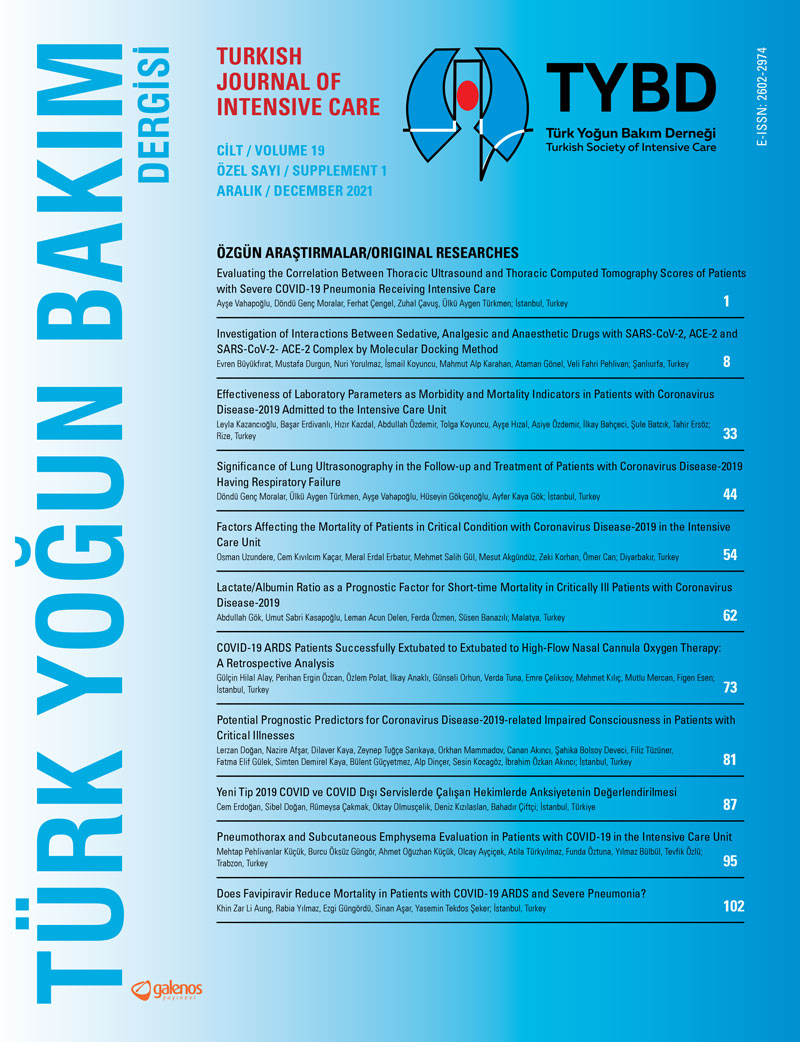Abstract
Objective:
Although there is no antiviral treatment specific to the virus, favipiravir has entered the treatment routine as an antiviral in our country in May 2020. In this study, in patients with severe acute respiratory syndrome coronavirus 2 (SARS-CoV-2) acute respiratory distress syndrome (ARDS) in the intensive care unit; The effects of favipiravir antiviral regimen on mortality and morbidity were evaluated.
Materials and Methods:
Patients admitted to the intensive care unit were divided into two groups as those who received favipiravir (group F; n=208) and those who did not (group N; n=101). The treatment of the cases is arranged according to current national guidelines. Metavision/QlinICU Clinical Decision Support Software, in intensive care unit; Acute Physiology and Chronic Health Evaluation-II, Sequential Organ Failure Assessment score, aspartate aminotransferase, alanine aminotransferase, urea, creatinine, lactate dehydrogenase, ferritin, C-reactive protein (CRP), procalcitonin, Pro-BNP, D-dimer, fibrinogen, white blood cell, neutrophil count (NEU), lymphocyte count (LYM), NEU/LYM, CRP, t1 acceptance (0th hour), t2 follow-up (24th hour) and t3 (discharge or ex) values of acute phase parameters, and the comorbidity is obtained by Structured Query Language queries. The primary outcome is mortality; secondary outcomes are possible drugrelated organ toxicities, sudden change of the level of the acute phase reactants, requirement of continuous renal replacement therapy (CRRT), hospitalization time, ventilator dependent days.
Results:
One hundred eight women (35%), 201 men (65%), a total of 309 cases were evaluated in the study. In the demographic data of the groups, no statistically significant difference was found between the frequency of comorbidity, mortality rate, CRRT need, and secondary infection. The mean increase of 107.66±628.99 units between the t1 and t3 measurement was found to be statistically significant in F group cases. In the F group, the neutrophil/lymphocyte ratio (NLR) during the follow-up period and the last NLR were found to be lower than the initial value.
Conclusion:
It was determined that favipiravir used in the treatment of SARS-CoV-2 ARDS has no superiority in preventing mortality.
Keywords: Favipiravir, COVID-19, ARDS, mortality
References
- Carlos WG, Dela Cruz CS, Cao B, Pasnick S, Jamil S. Novel Wuhan (2019-nCoV) Coronavirus. Am J Respir Crit Care Med 2020;201:P7-8.
- Song Y, Zhang M, Yin L, Wang K, Zhou Y, Zhou M, et al. COVID-19 treatment: close to a cure? A rapid review of pharmacotherapies for the novel coronavirus (SARS-CoV-2). Int J Antimicrob Agents 2020;56:106080.
- Treatment Guide for Adult Patients with Covid-19 compiled by the Scientific Committee (latest update 29/06/2021)
- Furuta Y, Komeno T, Nakamura T. Favipiravir (T-705), a broad spectrum inhibitor of viral RNA polymerase. Proc Jpn Acad Ser B Phys Biol Sci 2017;93:449-63.
- Dong L, Hu S, Gao J. Discovering drugs to treat coronavirus disease 2019 (COVID-19). Drug Discov Ther 2020;14:58-60.
- Wu C, Chen X, Cai Y, Xia J, Zhou X, Xu S, et al. Risk Factors Associated With Acute Respiratory Distress Syndrome and Death in Patients With Coronavirus Disease 2019 Pneumonia in Wuhan, China. JAMA Intern Med 2020;180:934-43.
- Surviving Sepsis Campaign Guidelines on the Management of Adults With Coronavirus Disease 2019 (COVID-19) in the ICU: First Update critical care medicine 2020. doi: 10.1097/CCM.0000000000004899
- ARDS Definition Task Force, Ranieri VM, Rubenfeld GD, Thompson BT, Ferguson ND, Caldwell E, et al. Acute respiratory distress syndrome: the Berlin Definition. JAMA 2012;307:2526-33.
- Cai Q, Yang M, Liu D, Chen J, Shu D, Xia J, et al. Experimental Treatment with Favipiravir for COVID-19: An Open-Label Control Study. Engineering (Beijing) 2020;6:1192-8.
- Chan KS, Lai ST, Chu CM, Tsui E, Tam CY, Wong MM, et al. Treatment of severe acute respiratory syndrome with lopinavir/ritonavir: a multicentre retrospective matched cohort study. Hong Kong Med J 2003;9:399-406.
- Chen C, Huang J, Cheng Z, Zhang Y, Cheng Z, Wu J, et al. Favipiravir versus arbidol for COVID-19: a randomized clinical trial [online]. Medrxiv preprint 2020. doi:https://doi. org/10.1101/2020.03.17.20037432
- Cao B, Wang Y, Wen D, Liu W, Wang J, Fan G, et al. A Trial of Lopinavir-Ritonavir in Adults Hospitalized with Severe Covid-19. N Engl J Med 2020;382:1787-99.
- Pilkington V, Pepperrell T, Hill A. A review of the safety of favipiravir - a potential treatment in the COVID-19 pandemic? J Virus Erad 2020;6:45-51.
- Mucha SR, Dugar S, McCrae K, Joseph D, Bartholomew J, Sacha GL, et al. Coagulopathy in COVID-19: Manifestations and management. Cleve Clin J Med 2020;87:461-8.
- Zhang L, Yan X, Fan Q, Liu H, Liu X, Liu Z, et al. D-dimer levels on admission to predict in-hospital mortality in patients with Covid-19. J Thromb Haemost 2020;18:1324-9.
- Henry BM, de Oliveira MHS, Benoit S, Plebani M, Lippi G. Hematologic, biochemical and immune biomarker abnormalities associated with severe illness and mortality in coronavirus disease 2019 (COVID-19): a meta-analysis. Clin Chem Lab Med 2020;58:1021-8.
- Mehta P, McAuley DF, Brown M, Sanchez E, Tattersall RS, Manson JJ, et al. COVID-19: consider cytokine storm syndromes and immunosuppression. Lancet 2020;395:1033-4.
- Deng Y, Liu W, Liu K, Fang YY, Shang J, Zhou L, et al. Clinical characteristics of fatal and recovered cases of coronavirus disease 2019 in Wuhan, China: a retrospective study. Chin Med J (Engl) 2020;133:1261-7.
- Lu R, Zhao X, Li J, Niu P, Yang B, Wu H, et al. Genomic characterisation and epidemiology of 2019 novel coronavirus: implications for virus origins and receptor binding. Lancet 2020;395:565-74.
- Xu B, Fan CY, Wang AL, Zou YL, Yu YH, He C, et al. Suppressed T cell-mediated immunity in patients with COVID-19: A clinical retrospective study in Wuhan, China. J Infect 2020;81:e51-e60.
- Li G, Xu F, Yin X, Wu N, Li Y, Zhang T, et al. Lactic dehydrogenase-lymphocyte ratio for predicting prognosis of severe COVID-19. Medicine (Baltimore) 2021;100:e24441.
Copyright and license
Copyright © 2021 The Author(s). This is an open access article distributed under the Creative Commons Attribution License (CC BY), which permits unrestricted use, distribution, and reproduction in any medium or format, provided the original work is properly cited.






















